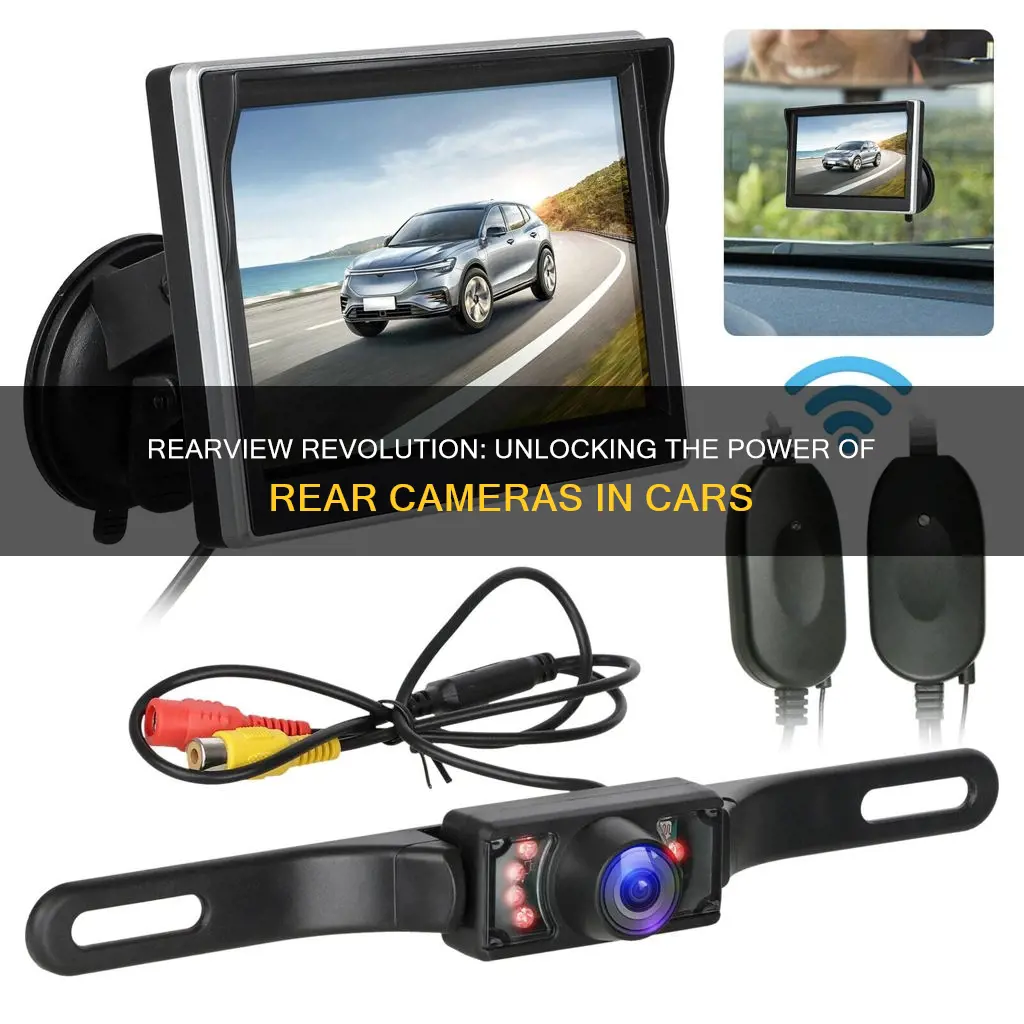
A rear camera, also known as a backup camera or reverse camera, is a standard safety feature in newer vehicles. It is a small, wide-angle camera installed on the back of a vehicle to help the driver see what's behind them. The camera turns on automatically when the car is put in reverse, displaying a mirror image on a monitor in front of the driver. This helps improve visibility and safety, especially when parking or backing up, and can also assist with blind spots. While rear cameras are now standard in new cars, they are not a replacement for mirrors or physically checking blind spots.
| Characteristics | Values |
|---|---|
| Purpose | To enable the driver to see behind the car properly and improve safety |
| Type of Image | Mirrored image |
| Activation | Automatic when the vehicle is put in reverse |
| Camera Lens | Wide-angle or fisheye lens |
| Camera Position | Mounted on the vehicle's bumper, or inside the car on the dashboard or sun visor |
| Camera Connection | Wired or wireless |
| Monitor Position | Center console or integrated into the rearview mirror |
| Additional Features | Cross-traffic alerts, parking sensors, moving parking guidelines |
What You'll Learn

Rear cameras are a standard safety feature in new vehicles
Rear cameras, also known as backup cameras, are a standard safety feature in new vehicles. They are small, wide-angle cameras mounted on the rear of a vehicle, often on the bumper, and are typically connected to the infotainment screen on the dashboard or a small monitor in the rear-view mirror. When the driver shifts into reverse, the camera automatically turns on, providing a clear view of the area behind the car. This helps to improve driver decision-making, prevent accidents, and enhance overall safety on the road.
The history of backup cameras dates back to 1956 when General Motors introduced the concept as part of the Buick Centurion. However, it was not until 1991 that Toyota brought the first practical backup camera system to the market with the Soarer Limited in Japan. In 2001, Nissan introduced the first rearview camera in the United States with the Infiniti Q45. Over the years, backup cameras gained popularity, and in 2014, the U.S. National Highway Traffic Safety Administration (NHTSA) mandated that all new vehicles manufactured after May 1, 2018, be equipped with backup cameras.
Backup cameras offer several benefits to drivers and improve overall road safety. Firstly, they increase rear visibility, making it safer to reverse and park, especially in tight spaces or busy areas. This not only reduces the risk of collisions with other vehicles but also helps prevent accidents involving pedestrians, especially children and the elderly, who are more vulnerable. In fact, a Consumer Reports survey revealed that 38% of respondents stated that their backup camera system helped them avoid a crash.
Additionally, backup cameras help eliminate blind spots and improve overall situational awareness. They are particularly useful in larger vehicles like SUVs or minivans, where it can be challenging to see just beyond the bumper, even with the aid of a rear-view mirror. Some backup camera systems also include advanced features such as cross-traffic alerts and parking sensors, providing audible warnings of nearby objects.
While rear cameras have become a standard safety feature, it is important to remember that they are not a replacement for mirrors or physically checking blind spots. Instead, they serve as an additional tool to enhance safety and should be used in conjunction with other safe driving practices.
Playback Zmodo Camera Footage on Your Computer
You may want to see also

They help eliminate blind spots
Rearview cameras, also known as backup cameras or reverse cameras, are designed to help drivers see behind their vehicles. They are usually installed on the back of a car and turn on automatically when the car is put into reverse gear. This helps the driver to see any objects or people behind the car that might otherwise be out of sight.
Backup cameras are particularly useful for parking, especially when parallel parking, and for increasing safety when reversing. They are also used to assist with blind spots, and can help drivers avoid collisions when changing lanes or merging into traffic.
Blind spots are areas of the road that a driver cannot see by looking in their mirrors or, in some cases, by looking over their shoulder. Blind spots can be particularly dangerous when changing lanes or merging into traffic, as a driver may not be aware of another vehicle or obstacle in their path. This is where rearview cameras come in.
Also known as blind-spot cameras, these devices display a live feed of the area beside and behind the vehicle on the infotainment screen or instrument cluster. This allows the driver to see any vehicles or obstacles that may be in their blind spot, without having to turn their head or rely solely on their mirrors. Blind-spot cameras are distinct from blind-spot monitors, which typically provide a warning light or chime when there is something in the driver's blind spot, but do not show a live video feed.
In addition to helping eliminate blind spots, rearview cameras offer several other benefits. They can improve safety for both the driver and other road users, including pedestrians, by reducing the risk of collisions when reversing. They can also make parking easier, particularly in tight or crowded spaces. According to a Consumer Reports survey, 38% of respondents said that their rearview camera had helped them avoid a crash.
Smartphone Camera Focus Lock: How to Engage It
You may want to see also

They make parking easier
Rear-view cameras, also known as backup cameras, are a standard safety feature in newer vehicles. They are typically attached to the back of the car, often on the tailgate, number plate holder, or bumper. When the car is put into reverse, the camera is automatically activated, providing a real-time feed of the area behind the vehicle. This feed is displayed on a screen on the car's dashboard, helping the driver to see any obstacles and reverse into tight spots more easily.
Rear-view cameras are particularly useful when parking, as they offer a clear view of the area behind the car, making it easier to manoeuvre into tight parking spaces. They eliminate blind spots, providing a wider field of view than traditional mirrors and helping drivers to see exactly what is behind their vehicle. This is especially beneficial when parallel parking, as the camera's perspective and guidelines assist drivers in positioning their car correctly.
Some rear-view camera systems also include on-screen parking assistance features, such as static or dynamic guidelines that adjust as the steering wheel is turned. These features further enhance the parking experience by guiding drivers into even the trickiest of parking spaces. Additionally, some cameras are equipped with night vision, improving visibility and making it safer to park in low-light conditions.
Overall, rear-view cameras are a valuable tool for drivers, making parking easier and safer, especially in busy areas or on narrow streets. They increase awareness of obstacles and help to avoid collisions, enhancing safety for both drivers and pedestrians.
Focusing Phantom 4 Camera: Tips for Clearer Shots
You may want to see also

They can be wired or wireless
Rearview cameras, also known as backup cameras, are designed to improve the driver's visibility of the rear of their vehicle. They are usually activated when the vehicle is put into reverse and are typically mounted on the vehicle's bumper. They can also be mounted inside the car on the dashboard or sun visor.
Backup cameras can be wired or wireless. Wired cameras have a physical connection between the camera and the display monitor, usually through a long wire cable. Wireless cameras, on the other hand, transmit images via radio signals to the monitor and receiver, which then convert them into video images.
Portable, all-in-one, or semi-permanent wired cameras are often purchased by people with smaller vehicles. They are typically connected to the sun visor with a long wire and have small display screens. Wireless systems, on the other hand, use airways to connect the camera and screen, but they may interfere with other wireless components, resulting in poor signal reception.
Wired systems are generally considered to provide better quality than wireless systems. However, wireless systems offer the advantage of being easier to install, as they do not require any wiring. Permanently installed wireless cameras still need a power source, and they are often hard-wired to the reverse lights so that the camera turns on only when the vehicle is shifted into reverse.
Lightroom CC and Camera Raw: Preset Compatibility
You may want to see also

They are typically mounted on the rear bumper
Rearview cameras, also known as backup cameras, are designed to improve the driver's visibility of the area behind their vehicle. They are typically mounted on the rear bumper, and they turn on automatically when the car is put into reverse gear. This helps the driver to see any obstacles, vehicles, or pedestrians that might be in their path. The image from the camera is displayed on a monitor, often in the centre console or integrated into the rearview mirror, and it is flipped horizontally to match the driver's perspective.
The positioning of the camera on the rear bumper is important for a few reasons. Firstly, it provides greater visibility of the area directly behind the car, which can be difficult to see through the rear window or rear-view mirror alone. Secondly, the camera is usually angled downwards to provide a clear view of the ground immediately behind the car, helping the driver to spot any low obstacles, such as curbs or speed bumps, that could cause damage to the vehicle.
In addition to being mounted on the rear bumper, some rearview cameras are installed inside the car, on the dashboard or sun visor. These cameras are typically wired, with a long cable connecting the camera to the display monitor. Wireless cameras are also available, transmitting images to the monitor via radio signals. However, wired cameras are generally considered to provide better quality and reliability than wireless systems.
The rearview camera has become an essential safety feature in modern vehicles. In the United States, backup cameras have been mandatory on all new passenger vehicles since 2018. This requirement was implemented by the National Highway Traffic Safety Administration (NHTSA) to reduce the number of backing accidents, which cause injuries and fatalities each year. By providing drivers with a clear view of the area behind their vehicle, rearview cameras help to prevent collisions and improve overall road safety.
Surveillance Cameras in Dressing Rooms: Are They Legal?
You may want to see also
Frequently asked questions
A rear camera, also known as a backup camera or reverse camera, is a safety feature in cars that helps the driver see behind the vehicle. It is usually a small, wide-angle camera mounted on the rear of the car.
When the driver shifts the gear into reverse, the rear camera automatically turns on and displays the view at the back of the car on a monitor. The image is mirrored to match the driver's perspective, and guidelines may be included to assist with parking.
Rear cameras improve safety by helping to prevent crashes and collisions when backing up. They also assist with parking, eliminating blind spots, and improving overall visibility. Additionally, they can help keep children and pets safe by providing a clear view of the area directly behind the car.
Rear cameras have become increasingly common in newer vehicles. Since 2018, the National Highway Traffic Safety Administration (NHTSA) in the United States has required carmakers to include backup cameras in all newly manufactured cars, trucks, and SUVs.
Rear cameras are typically mounted on the vehicle's rear bumper, near the license plate, or in the trunk lid. They are often aimed downward to provide a clear view of the area immediately behind the car.







